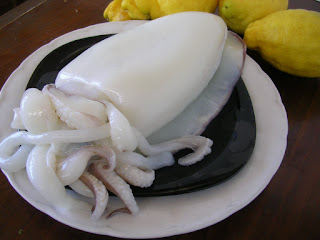 |
| Chicken cooks with shellfish in a rich sauce for Spanish surf 'n turf. |
When I first tasted the dish, also known as mar y montaña, sea and mountain, I assumed adding chicken was a way to extend the pricey lobster. A single lobster plus chicken could feed six or more. I have since read in Coleman Andrews’ CATALAN CUISINE that its origin was exactly the opposite, the lobster was to extend the chicken: “Chicken was expensive, taking time to raise and money to feed, while every cast of the net brought up shrimp and spiny lobster,” wrote Andrews. (Langosta, by the way, is spiny lobster, which has no claws. The kind with claws is called bogavante in Spanish.
I have come across many variations of mar y montaña (or mar i muntanya in Catalan). The three in Coleman Andrews’s book are chicken and shrimp; rabbit with snails, monkfish, cuttlefish and shrimp, and rabbit with pork, sole and mussels. The most elaborate version I found, Ampurdan style, calls for jumbo shrimp (langostinos), sea crayfish (cigalas), cuttlefish, mussels, sausage, pigs’ trotters, rabbit, chicken, snails and mushrooms!
What all of these land and sea combos have in common is the addition of a picada. Picada is a paste made of ground nuts, garlic and bread that both thickens and seasons the sauce. The picada for mar y montaña usually also contains chocolate. Now, that really is exotic! Unless, of course, you’ve already savored Mexican mole, also a sauce with ground nuts and chocolate.
 |
| Cuttlefish, cleaned and ready to cut up. |
Cuttlefish, like squid and octopus, is a cephalopod. It has eight short tentacles, an interior cuttlebone and ink sac. The medium-sized cuttlefish (jibia or sepia) shown in the photo is cleaned and ready to cut up. The thick flesh needs slow cooking (about an hour) to become tender. Tiny ones can be grilled or flash-fried.Over the years, I have adapted mar y montaña to suit myself, as lobster is not readily available or affordable. (Although, the last time I shopped at HiperCor, El Corte Ingles’s supermarket, I saw lobsters, the kind with claws, imported from Canada at a reasonable price.) I usually make the dish with free-range chicken and cuttlefish (jibia or sepia). Meaty cuttlefish has such a deep-sea flavor. If cuttlefish is not available, squid or monkfish could be used instead, although they do not require such long cooking.
Typically, a braised dish such as this is served on its own, with only crusty bread or triangles of fried bread as an accompaniment. But, because the picada-enriched sauce is so delicious, I like to serve rice as a side to soak it up. Yesterday, instead of rice, I served mar y montaña with creamy polenta. Wonderful.
 | |
| Chicken cooks with cuttlefish and shrimp in a sauce of almonds and chocolate. |
Mar y Montaña
Surf and Turf (Chicken with Seafood)
Serves 4 to 6.
2 tablespoons olive oil or lard
1 slice bread, crusts removed
3 cloves garlic
30 almonds, blanched and skinned
Parsley sprig
4 jumbo shrimp
2 pounds chicken in serving pieces
Salt and pepper
1 chicken liver (optional)
1 onion, chopped
1 cup chopped tomatoes (3 medium)
1 pound cleaned cuttlefish, cut in bite-size pieces
2/3 cup dry Sherry or white wine
1 tablespoon dry anisette or brandy
2/3 cup water or stock
Strip of orange zest
1 bay leaf
½ teaspoon saffron, crushed
1 ounce dark chocolate, chopped
Pinch of cinnamon
Fried bread to serve (optional)
Chopped parsley to garnish
Heat the oil or lard in a large cazuela or deep skillet. Fry the bread, 2 cloves of the garlic, almonds and a sprig of parsley until bread and almonds are golden. Skim out and reserve.
Sauté the jumbo shrimp in remaining oil until they are pink and just cooked through. Remove and set aside.
Season the chicken pieces with salt and pepper. Brown them in the fat with the chicken liver, if using. Remove the chicken pieces and liver when browned. Add the chopped onion and remaining clove of garlic, chopped. Sauté 5 minutes until onion begins to brown. Add the tomatoes and cook a few minutes over medium-high heat. Add the cut-up cuttlefish, Sherry, anisette, water, orange zest and bay leaf. Cover and simmer 15 minutes.
Return the chicken pieces (but not the liver) to the cazuela. Continue cooking until both cuttlefish and chicken are tender, about 40 minutes longer.
Meanwhile, prepare the picada. In a mortar, food processor or blender, grind together the fried bread, almonds, 2 cloves of garlic and parsley, chicken liver, saffron, chocolate and cinnamon. Mix with about ½ cup of sauce from the cazuela and blend to make a smooth paste.
Stir the picada into the cazuela. Cook 15 minutes longer. Place the shrimp on top and garnish with chopped parsley. Serve with strips of fried bread, if desired.
 |
| Chocolate is a secret ingredient in the sauce. |
This post brings it all back! I remember the first time I had "lobster" in the States. I was horrified. I couldn't understand what all the rage was. Everyone, everywhere raved about Maine lobster. I figured I got a bad lobster, and tried again. More horror. It took a while for me to figure out that the Langostas of Espana are nothing like the Lobstah of Maine. Ha Ha Ha.... the joke was on ME! I now call the stuff of Spain "langostina" to differentiate amongst Latinos in the States what lobster I'm referring to. Also caught your fabada post... my family is from Asturias, and they are cheese artisans. What joy to find you! I'm home again!!!
ReplyDeleteWendy: Besides the langosta/bogavante difference, there is also the cigala/langostino word problem. Asturian cheese is fabulous. Which type does your family make?
Delete